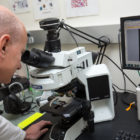Environmental Health
As Lyme Disease Spreads, Danbury Lab Focuses On Diagnostic Tools
|
For nearly nine years, scientists inside the boxy brick Western Connecticut Health Network Research Center have been working to develop a more accurate test to diagnose the scourge of the Connecticut woods: Lyme disease. Lyme disease is carried by the tiny blacklegged tick, commonly known as a deer tick. When a blacklegged tick infected with Lyme bites a human, it can transmit a tiny microscopic organism, called a spirochete, that moves around the human body, evading easy detection. Researchers in Danbury have been trying to detect that spirochete, similar to those that cause syphilis and other diseases, in people’s blood. Pathology research scientist Donna Guralski powered up her microscope and computer recently to show the culprit: a fluorescent green corkscrew-shaped organism that twisted around the screen, just as it would burrow through a person’s blood vessel walls and into tissue.
